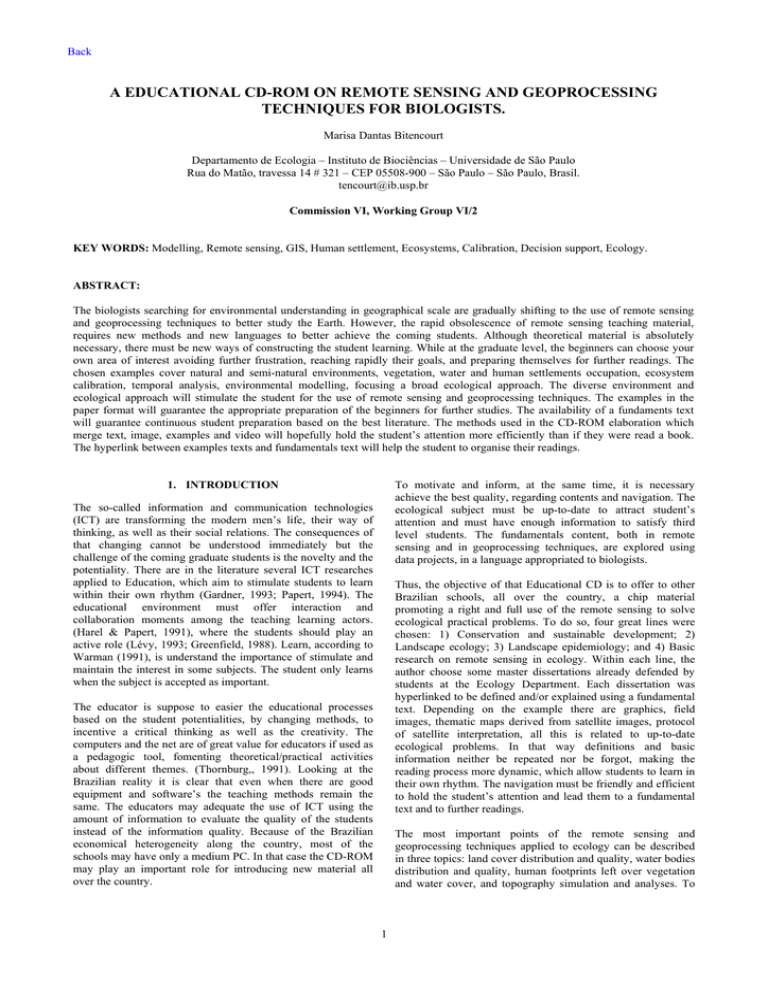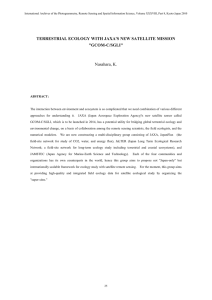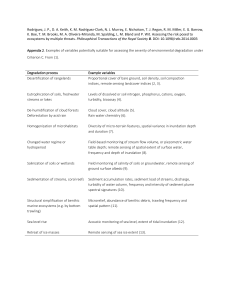A EDUCATIONAL CD-ROM ON REMOTE SENSING AND GEOPROCESSING TECHNIQUES FOR BIOLOGISTS.
advertisement

Back A EDUCATIONAL CD-ROM ON REMOTE SENSING AND GEOPROCESSING TECHNIQUES FOR BIOLOGISTS. Marisa Dantas Bitencourt Departamento de Ecologia – Instituto de Biociências – Universidade de São Paulo Rua do Matão, travessa 14 # 321 – CEP 05508-900 – São Paulo – São Paulo, Brasil. tencourt@ib.usp.br Commission VI, Working Group VI/2 KEY WORDS: Modelling, Remote sensing, GIS, Human settlement, Ecosystems, Calibration, Decision support, Ecology. ABSTRACT: The biologists searching for environmental understanding in geographical scale are gradually shifting to the use of remote sensing and geoprocessing techniques to better study the Earth. However, the rapid obsolescence of remote sensing teaching material, requires new methods and new languages to better achieve the coming students. Although theoretical material is absolutely necessary, there must be new ways of constructing the student learning. While at the graduate level, the beginners can choose your own area of interest avoiding further frustration, reaching rapidly their goals, and preparing themselves for further readings. The chosen examples cover natural and semi-natural environments, vegetation, water and human settlements occupation, ecosystem calibration, temporal analysis, environmental modelling, focusing a broad ecological approach. The diverse environment and ecological approach will stimulate the student for the use of remote sensing and geoprocessing techniques. The examples in the paper format will guarantee the appropriate preparation of the beginners for further studies. The availability of a fundaments text will guarantee continuous student preparation based on the best literature. The methods used in the CD-ROM elaboration which merge text, image, examples and video will hopefully hold the student’s attention more efficiently than if they were read a book. The hyperlink between examples texts and fundamentals text will help the student to organise their readings. To motivate and inform, at the same time, it is necessary achieve the best quality, regarding contents and navigation. The ecological subject must be up-to-date to attract student’s attention and must have enough information to satisfy third level students. The fundamentals content, both in remote sensing and in geoprocessing techniques, are explored using data projects, in a language appropriated to biologists. 1. INTRODUCTION The so-called information and communication technologies (ICT) are transforming the modern men’s life, their way of thinking, as well as their social relations. The consequences of that changing cannot be understood immediately but the challenge of the coming graduate students is the novelty and the potentiality. There are in the literature several ICT researches applied to Education, which aim to stimulate students to learn within their own rhythm (Gardner, 1993; Papert, 1994). The educational environment must offer interaction and collaboration moments among the teaching learning actors. (Harel & Papert, 1991), where the students should play an active role (Lévy, 1993; Greenfield, 1988). Learn, according to Warman (1991), is understand the importance of stimulate and maintain the interest in some subjects. The student only learns when the subject is accepted as important. Thus, the objective of that Educational CD is to offer to other Brazilian schools, all over the country, a chip material promoting a right and full use of the remote sensing to solve ecological practical problems. To do so, four great lines were chosen: 1) Conservation and sustainable development; 2) Landscape ecology; 3) Landscape epidemiology; and 4) Basic research on remote sensing in ecology. Within each line, the author choose some master dissertations already defended by students at the Ecology Department. Each dissertation was hyperlinked to be defined and/or explained using a fundamental text. Depending on the example there are graphics, field images, thematic maps derived from satellite images, protocol of satellite interpretation, all this is related to up-to-date ecological problems. In that way definitions and basic information neither be repeated nor be forgot, making the reading process more dynamic, which allow students to learn in their own rhythm. The navigation must be friendly and efficient to hold the student’s attention and lead them to a fundamental text and to further readings. The educator is suppose to easier the educational processes based on the student potentialities, by changing methods, to incentive a critical thinking as well as the creativity. The computers and the net are of great value for educators if used as a pedagogic tool, fomenting theoretical/practical activities about different themes. (Thornburg,, 1991). Looking at the Brazilian reality it is clear that even when there are good equipment and software’s the teaching methods remain the same. The educators may adequate the use of ICT using the amount of information to evaluate the quality of the students instead of the information quality. Because of the Brazilian economical heterogeneity along the country, most of the schools may have only a medium PC. In that case the CD-ROM may play an important role for introducing new material all over the country. The most important points of the remote sensing and geoprocessing techniques applied to ecology can be described in three topics: land cover distribution and quality, water bodies distribution and quality, human footprints left over vegetation and water cover, and topography simulation and analyses. To 1 The International Archives of the Photogrammetry, Remote Sensing and Spatial Information Sciences, Vol. XXXIV, Part 6, CVI subject. For more information regarding the examples, the CD users may open the PDF files. To introduce each example there are a video with a brief introduction lecture made by the author. Thus each student will choose the subject of his or her interest just listening. assess the biologists interested in the environment the most strait forward parameter to start with is vegetation cover. The manner nature distribute the target along the Earth surface is peculiar, leading the observer to distinguish between a disturbed from undisturbed areas. The way human being modify the Earth is also quite noticeable. Using satellite images one can quantify the surface modified by humans, not only in the present time but also in the past. With image processing one can quantify the amount of green vegetation present and the speed of deforestation processes. It is also possible to quantify degradation and regeneration, as well as the way the land is used either for cropping or raising cattle. With geoprocessing techniques one can measure areas, perimeters, distances of several parameters and phenomenon. Through digital elevation model (DEM) it is possible simulate the topographic conditions related to the habitat of plants and animals. With geographic information systems (GIS) it is possible to combine several set of data derived from different sources. Finally, one can model several environmental situations and produce maps that can support decision makers and field investigation. 3. RESULTS AND DISCUSSION To optimise the learning process, four research lines of the ecology that usually use remote sensing and GIS were chosen as examples. Some of those lines have strongly been modified by the recent advances in the image processing and their resolution improvements. The line # 1 treats of an ecological zoning in the buffer zone the Biosphere Reserve of the Manú National Park in Peru, where the Amazon River begins. Because it is a buffer zone the sustainable use is allowed. Thus, merging field data, cartographic data, and remote sensing derived information, in a GIS environment, it was possible to establish zones for free grazing, moderated grazing and prohibited grazing. The sustainable use of natural resources is only possible if a suitable regional planning is done, taking into account the agroecosystem characteristics of the region. The planning requires a previous zoning that includes the distinct degrees of protection and intervention. One way of zoning may relate carrying capacity with biotic and abiotic parameters. Because of its geographic and climatic conditions, that Manú National Park aspect presents a vegetation cover predominantly herbaceous, which is called “Páramos”. Located in the buffer zone of the Manu Biosphere Reserve, the Páramos are used as natural pasture by wild and domestic animals. The cattle, from local peasants communities invades the National Pak searching for food. The number of domestic animals, such as cattle, is significantly greater than number of wild animals. That use has been causing a significant degradation, such as a gradual loss of eatable species and soil erosion. The use of the natural pasture in the Andean region is generalised. However, specialised literature about sustainable use, of this kind of ecosystems, usually estimates carrying capacity taking into account presence, density, and eatable plant species, as well as, some abiotics factors. In the present study, abiotic (altitude and slope) and biotic (diversity and vegetation condition) variables have been integrated using spatial modelling in GIS environment. The outcome was the ecological zoning maps based on the environmental carry capacity and the animal necessity to survive. The line # 2 is another ecological zoning based in the landscape ecology theory, in Pedregulho municipality of São PauloBrazil, where is located the Furnas do Bom Jesus State Park, within the Cerrado domain. The State Park zoning present three main objectives: preservation, human use, and restoration. Each criterion had its relative importance evaluated according to its influence in obtaining the final objective through an analytical hierarchy process (AHP). A fuzzy membership function was applied to standardise the criteria in the same base for comparison; also, to qualify the park areas between more and less appropriate to be part of a zone, using Landscape Ecology concepts. An iterative process for area allocation separated the conflicting objectives. To produce maps with the areas indicated for each category of allocation, were used support decision models, developed in GIS environment, based on satellite images and several others cartographic maps available in the literature. Two aspect of the conservation are treated: natural resource and sustainable use. The legislation and actual use are presented in map format and analysed in GIS Because of the complexity of the ecological subject and the huge data volume usually equired, the GIS expertise is becoming essential for biologists interested in the environment evaluation. Thus, the general objective of this paper is to present a Educational CD-ROM built up for biologist-ecologist. The specific objective is to achieve as much Brazilians students as possible and offer the best experience accumulated at the Ecology Department, in the Biosciences Institute of the University of São Paulo (USP) in Brazil, during 15 years. The CD merged the remote sensing, geoprocessing and ecological experiences covering up-to-date problems. This project were supported by SIAE Program (Integrated System for Teaching Support), organised at USP since 1998, which is investing the development of teaching material using electronic media 2. MATERIAL AND METHODS The CD contents comprise three sets of data: fundamental text, examples text and video, and PDF texts. The first one was totally written by the author. The examples are short versions, also written by the author, based on master dissertations advised by the author at the Ecology Post-graduate Program / Biosciences Institute – USP, during 1998 and 2001. The PDF texts are the original dissertations in PDF format. The fundamental text is based on the best books available in its references topic. Each example presents their specific references. To stimulate students the author presents a short summary each example, in video format. The following window brings the example text, in the “paper” format. The CD ROM was made to run in Windows 98. To create the frames, Adobe Photoshop were used. The videos were recorded using a digital camera "Digital 8" format and exported within AVI to better adapt do Windows environment. The final CD ROM contents has a file auto-exec for PC, with ideal resolution for viewing of 800x600. The final product shows 5 examples of research related to ecological themes, remote sensing and geoprocessing Along the navigation the student will find vocabularies or expression which require more explanation. Thus, through hyperlink the user is lead to a file with fundaments, which may be either a paragraph or several pages, depending on the complexity of the 2 The International Archives of the Photogrammetry, Remote Sensing and Spatial Information Sciences, Vol. XXXIV, Part 6, CVI is the first evaluation made to make environmental diagnostic or to organise any ecological field trip. Thus, to understand that target spectral response, in all spectral bands, is the first think to be learned by any amateur. The conversion of digital number into reflectance is one way to avoid wrong interpretation of satellite derived maps, especially if the analyse were seasonal. In the line # 4 example, five cerrado physiognomies are accompanied, in the field and in satellite images, starting from the dry season of a year and ending in the wet season of the following year. The conversion into reflectance minimise sun angle and illumination conditions effects. environment in order to achieve the best possible zoning. The conflicts of conservation objectives are discussed as well as the solutions strategies. In the line # 3 there are two examples. The first one has the objective of predicting the spatial risk of human/malarian vector (Anopheles darlingis) contact after the lake of the UHE of Porto Primavera SP-Brazil were filled up. The malaria vector environmental requirements are: breeding place (shallow fresh water usually with macrophytes), refuge (woods) and blood source (domiciles and pasture). Thus, using geoprocessing techniques, remote sensing and cartographic data it were possible to identify the malarian vector environmental requirements merging thematic maps in a GIS environment. The satellite images were used to identify and quantify woods, pasture and domiciles. The breeding places were obtained from the analyses of the digital elevation model, simulation the flooding simulation. The results are areas with more or less risk of mosquitoes contact with humans depending of the distance that mosquitoes can fly and the human settlements are positioned. The DEM can be used to simulate environmental situations and to indicate habitat diversity. It also can be used to quantify areas with a specific altitude, slope, or aspect classes. Those characteristic can reflect the environmental condition of several species, either plant or animal. In the line # 3 example the DEM is used to predict shallow waters which is considered good breeding place for malarian vector new-borns. In the line # 1 example the DEM is used to localise abiotic fragility in the Páramos based on altitude, slope and aspect. The use of temporal analyses through PCA is not very familiar when the set of data is spectral response. However it may become usual if it were well explained. The only requirement to use the temporal PCA is to know how the studied target interact with each spectral band. In the line # 3 example presented here, the red band images are temporary analysed to show the human occupation in a period of Cutaneous Leishmaniasis occurrence in Itapira-SP. The red band were used because the lack of vegetation is indicated by high reflectance in that band. If an area is supposed to be vegetated the lack of vegetation means animal or even human occupations. The second case investigates the environmental factors involved in the vector/human contact, in actual cases of Cutaneous Leishmaniasis (CL) in Itapira – SP, Brazil. The Contact Risk Zones between man and CL vector were delimited and were observed from the viewpoint of the vegetation temporal evolution. To map the zones, the vegetation remnants were initially delimited in a satellite images, considering woods as the mosquitoes habitats. These limits were expanded according to mosquitoes flight range criteria (1000, 500 and 250 meters), generating maps. Inside those zones, for each criterion, altitude classes were extracted from Digital Elevation Model, and vegetation class were extracted from NDVI image. The vegetation temporal evolution was obtained with temporal Principal Component Analysis (PCA) of two satellite images (1992 and 1999), in which only second Principal Component (PC2) was classified and analysed. The use of map algebra for zoning purposes can be very risky if not well understood. In some of those examples the map algebra is used in several situations either to find the best land location or to find risk zones of human and diseases vectors contact. In the same manner, map algebra can help to rank potential uses of the land based on environmental conditions and locations. In the line # 1, 2 and 3 examples the use map algebra is frequent. Finally, in the line # 4 it is presented a study case where the spectral response of the Cerrado physiognomies is spatially and temporally studied in the field and in the satellite image. The study area is Gleba Pé-de-Gigante (Santa Rita do Passa Quatro – SP, Brazil) in a Cerrado conservation unit with all physiognomies. Thus, several satellite images were used looking for a spectral patter for each period of time and for each physiognomy. That project results from several other remote sensing/cerrado studies since 1985. In that example one can take a good look to the use of vegetation index to separate vegetation physiognomies based on the green leaves density per area. It is also demonstrated how each cerrado physiognomy behaves seasonally and how it appears in the satellite images obtained from the optical portion of the eletromagnetic spectrum. That research using images were accompanied by field trip during each season. In that example one can learn how to convert digital numbers, obtained in satellite images, into reflectance which more properly represents the target properties. That CD covers some important ecological uses of the remote sensing and geoprocessing techniques. The decision support is not very much used by ecologist due to the difficulties in handling huge amount of data, as commonly happens in ecology. To make the right decision one must choose correctly not only the objectives but also their constrains, which is the most difficult task. The example chosen gives some hints of how to make the best choices. In the line # 2 example offer a change to use some of the available decision support models. To supply the basic remote sensing and geoprocessing, a fundamental text with 70 pages were given in a PDF format. In that text there are the physics background of the remote sensing, the spectral response of the most important targets, the elementary image processing of optical, thermal and radar imagery. The text also brings the necessary background in cartography and geoprocessing fundaments. One can also find a good revision about vegetation indices, remote sensing of vegetation and water, mostly regarding the optical portion of the electromagnetic spectrum. There are also the basic fundaments regarding thermal and radar bands, with the spectral response of major targets. That text is hyperlinked with each one of the examples, trying to answer most the significant questions. The vegetation presence and absence are the most important hint either in plant, animal or human ecology. The use of spectral vegetation index to estimate green biomass presence and absence are the most important image processing that can be used by ecologists. The classification of the vegetation cover 3 The International Archives of the Photogrammetry, Remote Sensing and Spatial Information Sciences, Vol. XXXIV, Part 6, CVI WARMAN, R. S. 1991 - Ansiedade da informação: como transformar informação em compreensão. São Paulo, Cultura Ed. Associados. 4. CONCLUSION With so many examples in ecology, much more students may be interested in the CD. The diversity of subject, hopefully will lead to a better exploitation of the remote sensing use, giving to the student a change of experimenting other uses approaches. The platform used in that CD may be accessible to many Brazilian school all over the country. 6. AKNOWLEDGEMENTS The CD project is supported by the University of São Paulo in a Program called: SIAE-2001 (www.usp.br/siae) The most important remote sensing ecological uses are presented: NDVI seasonal variation, spectral signature variation, image rotation, and image spectral classification. The most important geoprocessing techniques applied to ecology are also presented: geocoding satellite image, DEM spatial analyses, map algebra, and decision support analyses. Since the experience at the Ecology Department of the University of São Paulo will continue, that CD may continually be improved, offering to remote Brazilians school, the chance to access up-to-date examples in the ecology domain. 5. REFERENCES APARÍCIO, C. 2001 – “Utilização de Geoprocessamento e Sensoriamento Remoto Orbital para análise espacial de paisagem com incidência de Leishmaniose Tegumentar Americana “.Master Dissertation at the Ecology Department – IB/USP, 111 pp BECERRA, J.A.B. 1999 - “Zoneamento Ecológico visando pastejo de comunidades vegetais das montanhas tropicais andinas, do Parque Nacional de Manú, Peru. ”. Master Dissertation at the Ecology Department – IB/USP, 72 pp GARDNER, H. 1985 - Frames of Mind: The Theory of Multiple Intelligences. New York: Basic Books. GREENFIELD, P. M.. 1988 - O Desenvolvimento do Raciocínio na Era da Eletrônica: os efeitos da TV, computadores e videogames. São Paulo: Summus, 162 p. HAREL, P.; PAPERT,L. 1991 - SSs (Eds). Constructionism. Ablex Publishing. LÉVY, P. 1993 - As tecnologias da Inteligência: o Futuro do Pensamento na Era da Informática. Trad. Carlos Irineu da Costa. Rio de Janeiro: Ed. 34. LUZ, B.R. 2000 – “Zoneamento Ecológico do Parque das Furnas do Bom Jesus, em Pedregulho-SP, usando Sensoriamento remoto e SIG”. Master Dissertation at the Ecology Department – IB/USP. 63p. MESQUITA JR, H.N. 1998 – “Análise temporal com sensor orbital de unidades fisionômicas de cerrado na Gleba Pé-deGigante (Parque Estadual de Vassununga – SP) “ Master Dissertation at the Ecology Department – IB/USP 118 pp. MUCCI, L.F. 1999 – “Modelagem espacial do risco epidemiológico para malária em porção paulista da zona de influência do reservatório de Porto Primavera” Master Dissertation at the Ecology Department – IB/USP 108 pp. THORNBURG, D. D. 1991 - Education, Technology and Paradigms of change for the 21st century, USA: Starsong Publications, p. 29 e 143. 4





